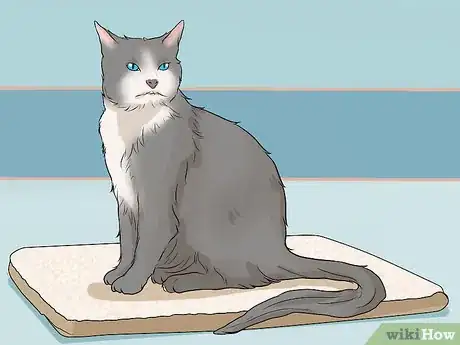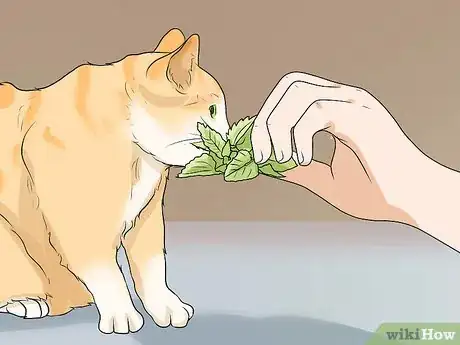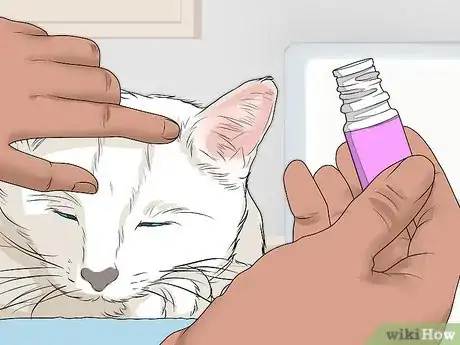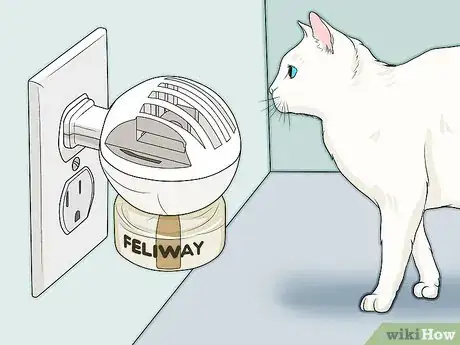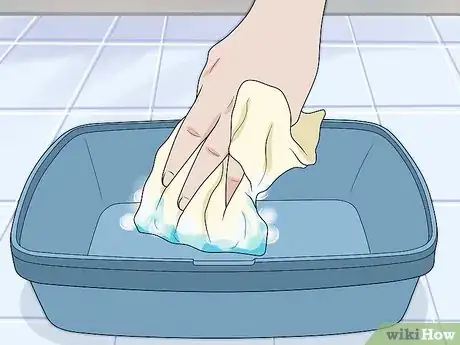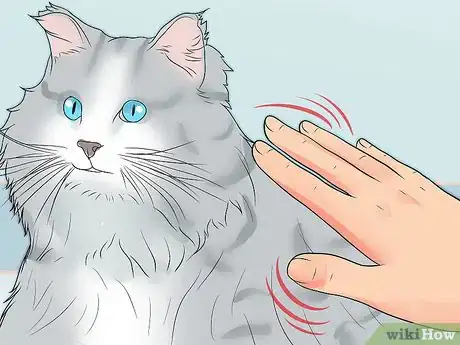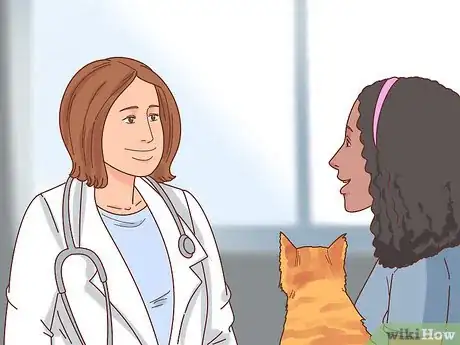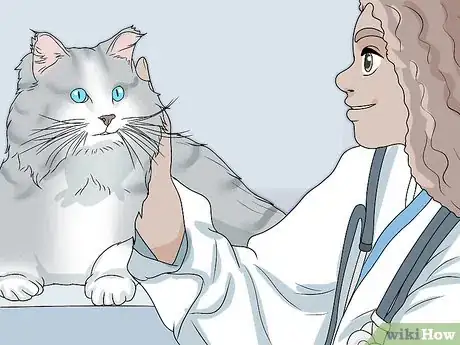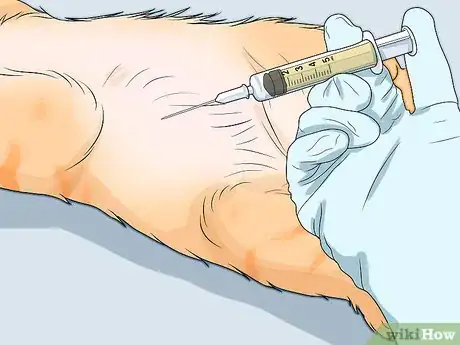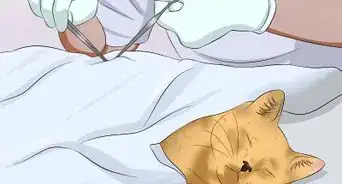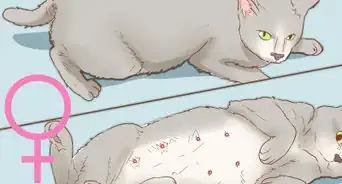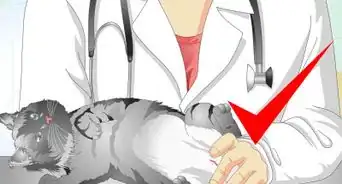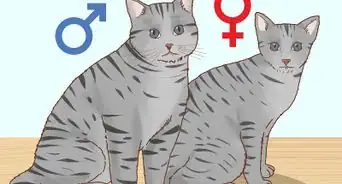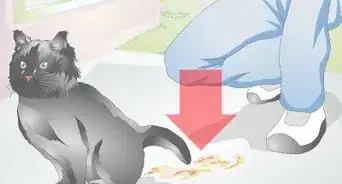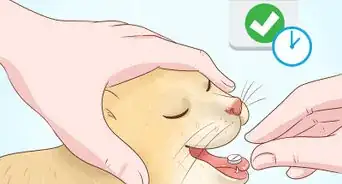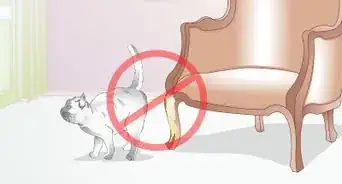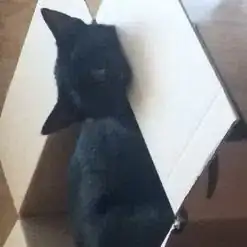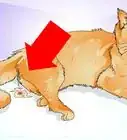This article was co-authored by Pippa Elliott, MRCVS. Dr. Elliott, BVMS, MRCVS is a veterinarian with over 30 years of experience in veterinary surgery and companion animal practice. She graduated from the University of Glasgow in 1987 with a degree in veterinary medicine and surgery. She has worked at the same animal clinic in her hometown for over 20 years.
There are 8 references cited in this article, which can be found at the bottom of the page.
wikiHow marks an article as reader-approved once it receives enough positive feedback. This article received 82 testimonials and 92% of readers who voted found it helpful, earning it our reader-approved status.
This article has been viewed 1,607,705 times.
An un-spayed female cat will go into heat, meaning she's ready to mate, every three to four weeks.[1] Usually, this involves howls, screeches, writhing, and attempts to attract or run away with male cats.[2] Dealing with a restless, frisky kitty may seem like a challenging task, but it’s not nearly as difficult as you may think. We’ve outlined plenty of quick tips and suggestions to help calm your cat down in the short term, as well as some solutions to prevent heat in the long term. In just a few minutes, you’ll be able to give your cat the support and respite she needs during this tough time.
Steps
Calming a Cat in Heat
-
1Recognize that your cat is in heat. Make sure that the behavior your cat is expressing actually means that she’s in heat and not sick. An unspayed cat in heat will vocalize a lot, be restless, rub against people and objects, and roll around on the floor. If you stroke her lower back, she'll respond by raising her pelvis and shifting her tail to one side.[3]
- The normal breeding season for cats is between spring and late summer. She will likely go into heat during this time of year.
- Decide if your cat's in heat or sick. If she's acting restless, but not rubbing herself against everything and lifting her tail to the side, she may be in pain. Take her to the vet to find out what's going on.
-
2Isolate her from male cats. When she's in heat, your cat will grow even more excitable in the presence of males. Do not allow her outside at all, and close all windows and lock all doors, including pet flaps. To keep her calm (and prevent her from getting pregnant), you need to keep her away from all male cats. Isolation will also keep her safe — she may try to escape your home if she senses a male outside.[4]
- If you have a male cat in the same house, find a friend or hire a cat sitter to take him in for a couple weeks. If the two cats stay in the same area, they'll both act wild, and almost certainly end up mating.
- If male cats are visible through a window, cover the window with curtains or a piece of cardboard.
Advertisement -
3Give your cat something warm to sit on. Although success is not guaranteed, some people find that giving the cat a heat pack or a warm, wet towel to sit on keeps her still and calm.[5] A microwavable heat pack may be the easiest option, since you can quickly reheat it once the cat starts acting up again. An electric heat pad/blanket is also a good choice.
-
4Use catnip only if it calms your cat down. Cats respond very differently to catnip. Some relax and quiet down when given catnip, but other become energetic and aggressive.[6] If you don't know how your cat responds to catnip, avoid this method. It may make the situation even worse.
- Note that this is only a temporary fix, but it might buy you an hour or two of peace.
-
5Test whether herbal remedies are effective. There are many herbal remedies on the market intended to calm cats. Some cat owners report success, but there is no single remedy that works on every cat. Furthermore, your cat may not respond to any of these products. Buy a collection of small samples and try several different remedies. Once you've found a product that works for your cat, buy it in larger amounts.
- Follow the instructions on the labels. They may tell you to add the remedy to the cat's water, rub a few drops into the cat's fur, or use as an air freshener.
- Do not use products intended for humans, which likely use higher dosages.
-
6Use Feliway in your home. Feliway is a synthetic cat pheromone that has a soothing, calming effect on cats. It takes a couple weeks of exposure to begin calming cats down, though, so it's not an immediate fix. If you know your cat is unspayed, you might consider plugging in the Feliway diffuser at the beginning of breeding season (spring). That way, whenever she goes into heat, the Feliway will already be built up in her system.
-
7Keep her litter box clean. Cats often scent mark with urine to attract males when they are in heat. By keeping her litter box clean at all times, you might encourage her to use it instead of scent marking your home. If she scent marks anyway, clean and de-odorize the area immediately. Leaving the smell of urine behind will only drive her to keep doing it.
- Don't use cleaning products with ammonia. Ammonia is also found naturally in urine, and the smell will encourage her to mark that spot again.
-
8Play with your cat. Playing with your cat can distract her temporarily, but she'll often go straight back to howling after you're done. Petting, scratching, or brushing her lower back can be more effective, if your cat is already calm enough to let you do so.[7]
Spaying and Other Long-Term Solutions
-
1Spay the cat. Spaying a cat removes her ovaries and prevents the heat cycle from occurring. It prevents her from getting pregnant, and reduces the risk of certain cancers and other diseases.[8]
- If you can't afford the surgery, look for low-cost spay services. Many clinics offer this service at a reduced price because it reduces the population of stray cats.
- Look up your area in the databases listed on the USDA website.
- There is a small chance of leftover ovarian tissue sending the cat into heat even after the surgery. If this occurs, consult a veterinarian.
-
2Consider waiting until after the heat is over before spaying. A vet can perform the spaying procedure at any point in your cat's hormonal cycle — even when she's in heat. However, there's a risk of increased blood loss at that time. The procedure is possible, but consult an experienced veterinarian for advice.[9]
-
3Use hormonal therapy as a last resort. The hormones prostaglandin and estrogen can be used to stop a cat’s heat cycle; however, this treatment has serious side effects including uterine infection and tumors.[10] Because of the risks, take this step only when spaying is not an option. Always consult in detail with a vet, who will need to prescribe the hormones and explain how to use them properly.[11] Even if the cat can't be spayed for medical reasons, the risks may not be worth the calm behavior.
Expert Q&A
-
QuestionIs it painful for my cat when she's in heat?
 Pippa Elliott, MRCVSDr. Elliott, BVMS, MRCVS is a veterinarian with over 30 years of experience in veterinary surgery and companion animal practice. She graduated from the University of Glasgow in 1987 with a degree in veterinary medicine and surgery. She has worked at the same animal clinic in her hometown for over 20 years.
Pippa Elliott, MRCVSDr. Elliott, BVMS, MRCVS is a veterinarian with over 30 years of experience in veterinary surgery and companion animal practice. She graduated from the University of Glasgow in 1987 with a degree in veterinary medicine and surgery. She has worked at the same animal clinic in her hometown for over 20 years.
Veterinarian No, she is not in pain although it is entirely normal for her to cry out and yowl as if in discomfort. This is just her way of attracting male attention.
No, she is not in pain although it is entirely normal for her to cry out and yowl as if in discomfort. This is just her way of attracting male attention. -
QuestionHow long does heat in cats last?
 Pippa Elliott, MRCVSDr. Elliott, BVMS, MRCVS is a veterinarian with over 30 years of experience in veterinary surgery and companion animal practice. She graduated from the University of Glasgow in 1987 with a degree in veterinary medicine and surgery. She has worked at the same animal clinic in her hometown for over 20 years.
Pippa Elliott, MRCVSDr. Elliott, BVMS, MRCVS is a veterinarian with over 30 years of experience in veterinary surgery and companion animal practice. She graduated from the University of Glasgow in 1987 with a degree in veterinary medicine and surgery. She has worked at the same animal clinic in her hometown for over 20 years.
Veterinarian This is very variable. A cat can 'call' anywhere between one to seven days. If she doesn't mate she can come into heat again a couple of weeks later. Thus the full cycle takes on average around three weeks.
This is very variable. A cat can 'call' anywhere between one to seven days. If she doesn't mate she can come into heat again a couple of weeks later. Thus the full cycle takes on average around three weeks. -
QuestionWhat age do cats generally have their first heat?
 Pippa Elliott, MRCVSDr. Elliott, BVMS, MRCVS is a veterinarian with over 30 years of experience in veterinary surgery and companion animal practice. She graduated from the University of Glasgow in 1987 with a degree in veterinary medicine and surgery. She has worked at the same animal clinic in her hometown for over 20 years.
Pippa Elliott, MRCVSDr. Elliott, BVMS, MRCVS is a veterinarian with over 30 years of experience in veterinary surgery and companion animal practice. She graduated from the University of Glasgow in 1987 with a degree in veterinary medicine and surgery. She has worked at the same animal clinic in her hometown for over 20 years.
Veterinarian Cats usually have their first heat at about 5 ½ to 6 months of age. However, this depends on the weather and how easy food is for the cat to come by. For example, in spring, a well fed cat may come into heat as young as 5 months old.
Cats usually have their first heat at about 5 ½ to 6 months of age. However, this depends on the weather and how easy food is for the cat to come by. For example, in spring, a well fed cat may come into heat as young as 5 months old.
References
- ↑ Reproduction in the Dog and Cat. Christianseen. Publisher: Baillierie-Tindal
- ↑ https://vcahospitals.com/know-your-pet/estrus-cycles-in-cats
- ↑ http://pets.thenest.com/remedies-calm-female-cat-heat-8859.html
- ↑ http://www.pet-happy.com/how-to-prevent-unwanted-pregnancy-in-cats/
- ↑ https://thecatsite.com/threads/how-do-i-calm-my-poor-kitten-in-heat.237970/
- ↑ http://www.vetinfo.com/home-remedies-for-cats-in-heat.html
- ↑ http://pets.thenest.com/remedies-calm-female-cat-heat-8859.html
- ↑ http://www.peteducation.com/article.cfm?c=1+2235&aid=925
- ↑ http://www.aspca.org/pet-care/cat-care/spay-neuter
About This Article
One way to calm a cat in heat is by keeping her indoors, separated from male cats who might frighten her or try to get her pregnant. Then, place a heating pad or a warm blanket in her bed for her to lay on, which will keep her warm and calm. Be sure to keep her litter box clean to control spraying inside of your home, and if she does spray any part of your house, clean the area thoroughly so that no scent remains. Give her plenty of attention by petting, scratching, or brushing her, and give her catnip if it normally helps to calm her when she’s not in heat. To learn more herbal and natural remedies from our Veterinarian co-author, keep reading!


